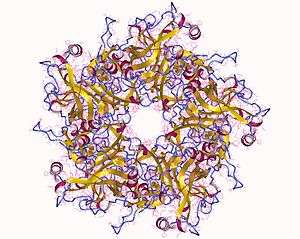Late protein
A late protein is a viral protein that is formed after replication of the virus.[1] One example is VP4 from simian virus 40 (SV40).[2]
| L1 (late) protein | |||||||||
|---|---|---|---|---|---|---|---|---|---|
 Major capsid protein L1 pentamer, Human papillomavirus 11 | |||||||||
| Identifiers | |||||||||
| Symbol | Late_protein_L1 | ||||||||
| Pfam | PF00500 | ||||||||
| InterPro | IPR002210 | ||||||||
| SCOPe | 1dzl / SUPFAM | ||||||||
| |||||||||
| Late Protein L2 | |||||||||
|---|---|---|---|---|---|---|---|---|---|
| Identifiers | |||||||||
| Symbol | Late_protein_L2 | ||||||||
| Pfam | PF00513 | ||||||||
| InterPro | IPR000784 | ||||||||
| |||||||||
In Human papillomaviruses
In Human papillomavirus (HPV), two late proteins are involved in capsid formation: a major (L1) and a minor (L2) protein, in the approximate proportion 95:5%. L1 forms a pentameric assembly unit of the viral shell in a manner that closely resembles VP1 from polyomaviruses. Intermolecular disulphide bonding holds the L1 capsid proteins together.[3] L1 capsid proteins can bind via its nuclear localisation signal (NLS) to karyopherins Kapbeta(2) and Kapbeta(3) and inhibit the Kapbeta(2) and Kapbeta(3) nuclear import pathways during the productive phase of the viral life cycle.[4] Surface loops on L1 pentamers contain sites of sequence variation between HPV types. L2 minor capsid proteins enter the nucleus twice during infection: in the initial phase after virion disassembly, and in the productive phase when it assembles into replicated virions along with L1 major capsid proteins. L2 proteins contain two nuclear localisation signals (NLSs), one at the N-terminal (nNLS) and the other at the C-terminal (cNLS). L2 uses its NLSs to interact with a network of karyopherins in order to enter the nucleus via several import pathways. L2 from HPV types 11 and 16 was shown to interact with karyopherins Kapbeta(2) and Kapbeta(3).[5][6] L2 capsid proteins can also interact with viral dsDNA, facilitating its release from the endocytic compartment after viral uncoating.
See also
References
- "DNA Virus Replication".
- Daniels R, Sadowicz D, Hebert DN (July 2007). "A very late viral protein triggers the lytic release of SV40". PLoS Pathog. 3 (7): e98. doi:10.1371/journal.ppat.0030098. PMC 1924868. PMID 17658947.
- Sapp M, Volpers C, Muller M, Streeck RE (September 1995). "Organization of the major and minor capsid proteins in human papillomavirus type 33 virus-like particles". J. Gen. Virol. 76 (9): 2407–12. doi:10.1099/0022-1317-76-9-2407. PMID 7561785.
- Nelson LM, Rose RC, Moroianu J (February 2003). "The L1 major capsid protein of human papillomavirus type 11 interacts with Kap beta2 and Kap beta3 nuclear import receptors". Virology. 306 (1): 162–9. doi:10.1016/S0042-6822(02)00025-9. PMID 12620808.
- Bordeaux J, Forte S, Harding E, Darshan MS, Klucevsek K, Moroianu J (August 2006). "The l2 minor capsid protein of low-risk human papillomavirus type 11 interacts with host nuclear import receptors and viral DNA". J. Virol. 80 (16): 8259–62. doi:10.1128/JVI.00776-06. PMC 1563822. PMID 16873281.
- Darshan MS, Lucchi J, Harding E, Moroianu J (November 2004). "The l2 minor capsid protein of human papillomavirus type 16 interacts with a network of nuclear import receptors". J. Virol. 78 (22): 12179–88. doi:10.1128/JVI.78.22.12179-12188.2004. PMC 525100. PMID 15507604.